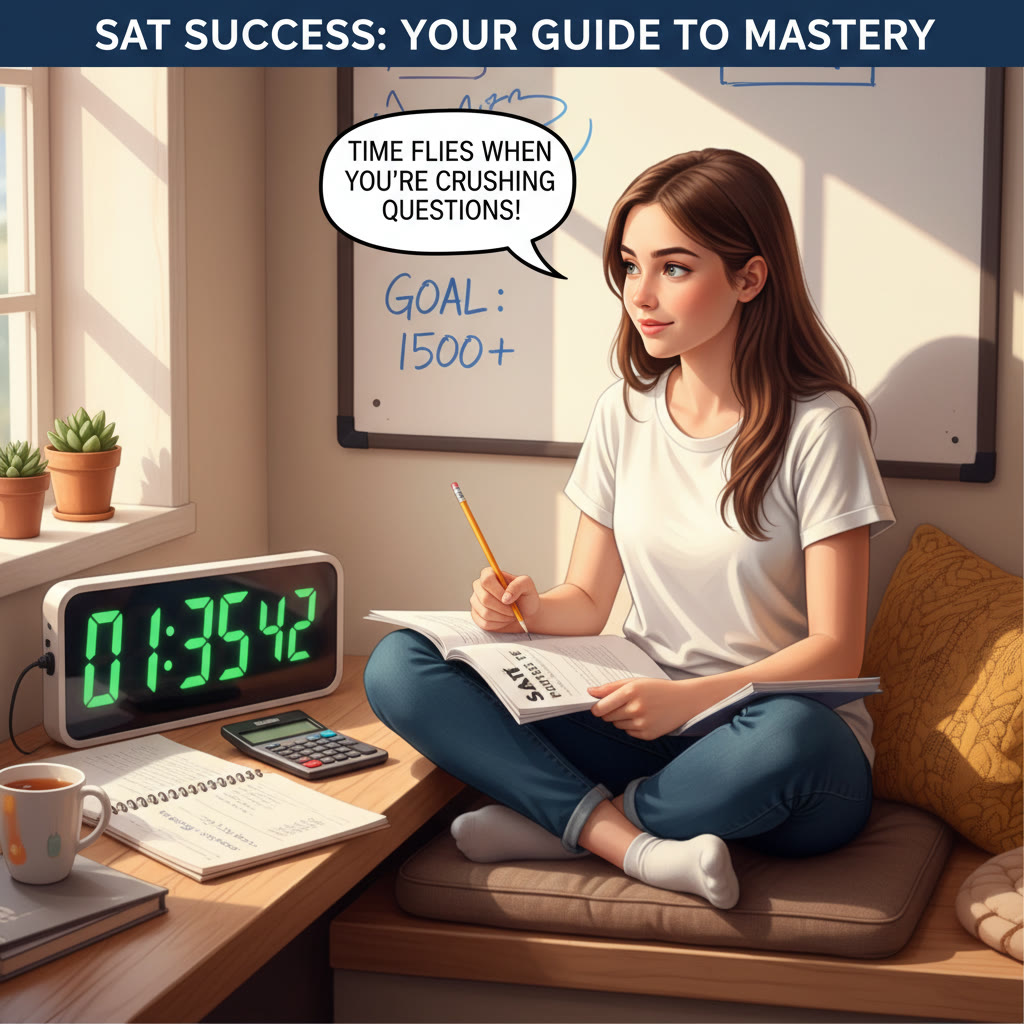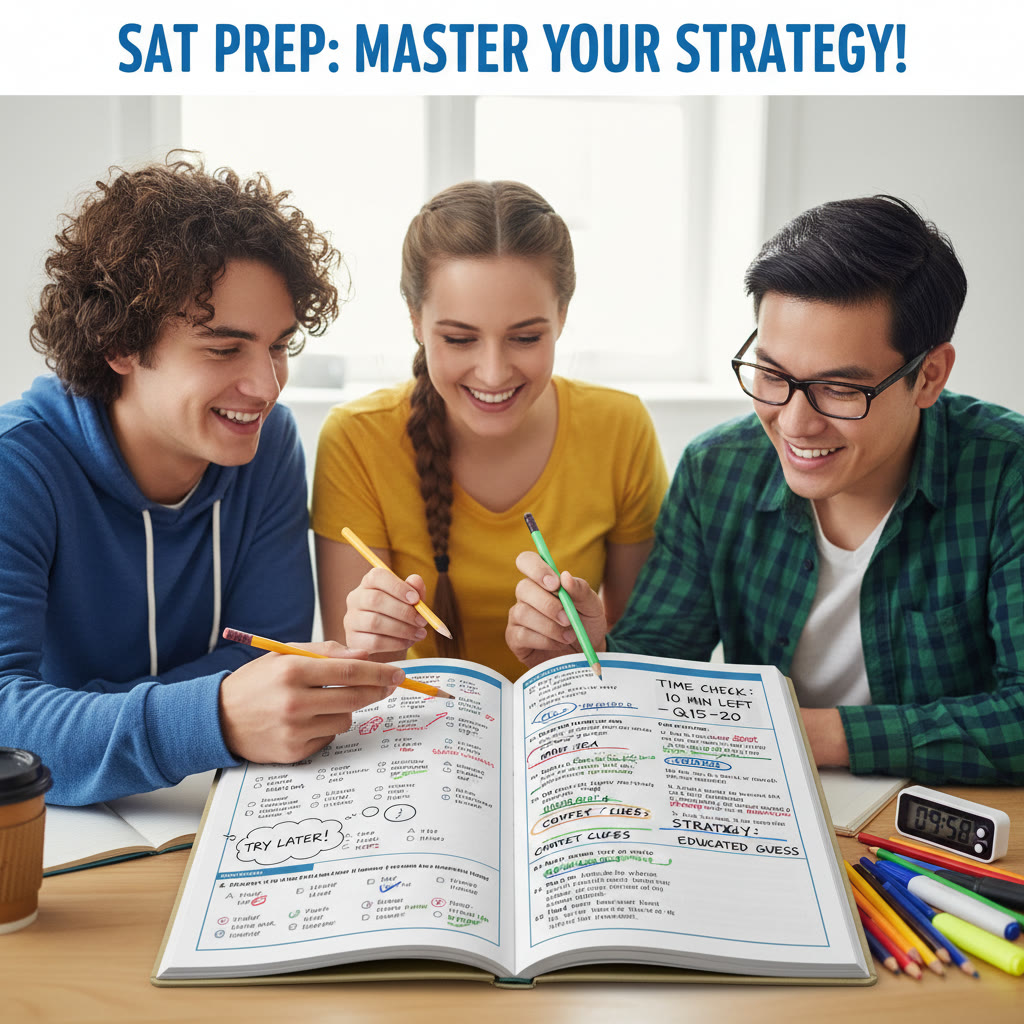How to Manage Time Effectively While Preparing for the SAT
There’s something quietly powerful about good timing. The SAT is a test of skills, yes, but it’s also a test of how well you manage the clock. You can know the math formulas and reading strategies inside out, but if you run out of time on test day, those strengths don’t fully show up in your score. This guide is a friendly, practical walkthrough on how to manage time while preparing for the SAT—so your knowledge gets the chance to shine.
Start with a Smart Diagnostic: Get the baseline
Before you schedule study blocks or commit to a plan, take one full, timed diagnostic test. This isn’t to stress you out; it’s to find out where your time sinks are. Are you slow on long reading passages? Do you spend too many minutes on tricky grid-in problems in the Math section? The diagnostic gives you two invaluable gifts: clarity about what needs the most practice, and a realistic sense of how far you have to go.
How to run the diagnostic
- Simulate test conditions: quiet space, no phone, official timing for sections.
- Use an official practice test whenever possible—accuracy of feedback matters.
- Take notes while you work: track which question types drain time and where you make careless errors.
When you finish, don’t just glance at the score. Read each missed question, categorize mistakes (timing, concept, misread), and build a quick spreadsheet or list of patterns. These patterns will shape your practice schedule.
Design a Time-Aware Study Plan
Effective time management starts before the stopwatch. Your study plan should balance long runs (full practice tests) with short, focused sessions that attack specific weaknesses. Think of your study plan as a running program for a marathon: you need endurance days and speedwork days.
Key elements of a smart plan
- Consistency over intensity: shorter daily sessions beat irregular marathon cram sessions.
- Mix timed practice with untimed review: timed practice trains pacing; untimed review builds understanding.
- Schedule one full, timed practice test every 1–2 weeks as you progress.
- Adjust study blocks based on your diagnostic and ongoing results—this is where tailored guidance helps.
If you want a head start on personalization, consider Sparkl’s personalized tutoring. Tutors can help craft a study plan that matches your diagnostic patterns—1-on-1 guidance, tailored study plans, expert tutors, and AI-driven insights make those plans precise and flexible.
Pacing by Section: What the Clock Really Means
Knowing the SAT’s structure lets you translate total minutes into per-question strategies. Here are the standard section lengths and a quick per-question pace you can use as a baseline. Keep in mind different question types will require different pacing within each section.
| Section | Time | Questions | Average time per question |
|---|---|---|---|
| Reading | 65 minutes | 52 | ~75 seconds |
| Writing & Language | 35 minutes | 44 | ~48 seconds |
| Math (No Calculator) | 25 minutes | 20 | ~75 seconds |
| Math (Calculator) | 55 minutes | 38 | ~87 seconds |
These averages are only a starting point. Some Reading questions are quick vocabulary-in-context items; some are multi-step evidence-based questions that need more time. Good pacing means knowing when to move on and when to slow down.
Practical per-section strategies
- Reading: Skim the passage structure (topic sentence, tone, purpose) in the first 1–2 minutes, then attack questions in clusters. Don’t read every sentence as if it’s a puzzle—learn to spot the anchor sentences that typically contain the answers.
- Writing & Language: These are fast. Watch for subject-verb agreement, parallel structure, and concision. If you can rule out two options quickly, make the best choice and move on—don’t get stuck over small wording nuances.
- Math: Use a triage method—do the straightforward problems first, flag the tougher ones, and return. For grid-in or multi-step problems, do a quick estimate to check plausibility before investing several minutes.
Daily Routines That Build Time Muscle
Time management in SAT prep isn’t a one-off skill; it’s a habit. These daily routines build the mental stamina to race against the clock without panicking.
Sample micro-schedule (30–90 minutes)
- Warm-up (5–10 minutes): flashcards, formulas, or a quick grammar drill to activate your brain.
- Focused block (20–40 minutes): timed question sets—five reading questions or a 20-minute math mini-section.
- Review (10–15 minutes): immediate review of errors and one-sentence notes on why you missed them.
- Cool-down (5 minutes): a quick reflection—what pace felt comfortable? Which question type slowed you down?
Short, focused sessions with immediate feedback beat long passive studying. The immediate review is crucial: it turns time pressure into learning signals instead of just stress.
Practice Tests: Your Weekly Checkpoint
Full practice tests are non-negotiable. They build endurance and show whether your pacing strategies hold up under fatigue. Treat these practice tests like real exams—simulate conditions.
How to analyze a practice test (the 4-step loop)
- Score and identify which section(s) lost the most time or points.
- Classify missed questions by type (timing, careless error, concept gap).
- Create a micro-plan: two targeted drills for the week focusing on your weakest categories.
- Re-test in a week on similar timed sets to ensure improvement.
Over several practice tests you’ll notice trends: maybe you slow down in the late Reading passages, or your accuracy dips toward the end of the Math section. Those are the places to insert endurance-building sessions—longer timed readings or back-to-back math sets to simulate fatigue.
Time-Saving Techniques During the Test
On test day, strategy beats speed. A few reliable habits will save minutes that add up to real score gains.
Smart habits to practice
- Answer easy questions first. Circle hard ones and return—don’t let one problem eat five minutes.
- Use process-of-elimination quickly. Narrowing to two choices gives you a 50% chance; don’t waste time hunting for perfection.
- Mark up the test booklet: underline key lines, bracket evidence, and jot brief notes. This saves time on rereads.
- Estimate answers in Math when possible. A rough estimate often reveals calculation errors quickly.
- Use consistent timing checks—glance at the clock after each passage or 10 questions to keep pace.
Practicing these moves in timed settings makes them automatic. That’s where tutors or structured programs can help: they create the repetitive, targeted practice that turns conscious pacing tactics into second nature.
Handle Stress Without Losing Time
Stress is a time thief. It slows decision-making and turns a ten-second hesitation into a minute-long spiral. Here are quick ways to manage stress so your time stays productive.
Quick anxiety-reduction techniques
- Box breath: 4 seconds in, 4 hold, 4 out, 4 hold—30 seconds calms the nervous system.
- Micro-routines: a consistent test-day warm-up (brief review of formulas, quick grammar checklist) stabilizes focus.
- Refocus ritual: if you find your mind wandering, take 10 seconds to refocus by rereading the question stem and circling the key phrase.
On test day, if you miss a question or lose time, don’t punish yourself mentally. Move on and come back. Smart recovery is a pacing skill as much as knowing how many seconds per question.
How to Track Progress Without Getting Lost in Numbers
Tracking is essential, but there’s a difference between useful measurement and anxiety-inducing metrics. Track a handful of meaningful indicators and update them weekly.
Useful metrics to track
- Section accuracy under timed conditions (Reading, Writing, Math separately).
- Average time per question for each question type.
- Number of questions left unanswered at the end of a section.
- Improvement on the same question types across practice tests.
Treat the metrics as signals. If your average time per question drops but accuracy also drops, you rushed too much—you need to balance speed with accuracy. If time stays steady but accuracy improves, your skills and time management are both improving.
Weekly and Monthly Planning Examples
Here’s a sample plan for a student who has 8–12 weeks to prepare. The pattern balances endurance, focused skill-building, and review.
| Week | Focus | Practices | Goal |
|---|---|---|---|
| 1–2 | Diagnostic + basics | 1 full test, daily 30–45 min focused drills | Baseline score, identify weak areas |
| 3–4 | Targeted skill work | 1 full test/week, 4 timed mini-sessions/week | Improve weak categories, practice pacing |
| 5–6 | Endurance + timing | 1 full test/week, 1 long reading day, 1 long math day | Hold pace under fatigue |
| 7–8 | Refinement & review | 1 full test/week, targeted drills, low-stress review | Polish weak spots, preserve endurance |
One practical way to speed up progress is to use Sparkl’s personalized tutoring. Tutors can help you prioritize which weak spots to attack each week, provide 1-on-1 guidance to shorten the learning curve, and use AI-driven insights to show where time improvements will yield the biggest score gains.
Examples: Small Changes, Big Time Savings
Little changes in habit can save minutes every section. Here are concrete examples students can practice immediately.
- Reading: Instead of reading the whole passage first, read the question stems quickly, then scan for the exact lines that contain the evidence—saves several minutes per passage.
- Writing: Learn the three or four most common grammar traps you personally miss. For many students, mastering these traps alone reduces time spent deliberating by half.
- Math: Memorize common values (squares up to 25, common fraction-decimal conversions) so you don’t pull out the calculator for trivial steps.
When to Get Help: Recognize Diminishing Returns
If you’re consistently practicing but your timed accuracy isn’t improving, it’s time to change the approach. That’s the point where targeted help accelerates progress: a tutor or a focused program can spot inefficient habits you can’t see from inside the practice loop.
Personalized tutoring—like Sparkl’s—can identify subtle pacing issues, provide 1-on-1 guidance, and build a tailored study plan so every minute of your prep works harder. The benefits are practical: fewer hours wasted, clearer drills, and confidence that your timing strategy is optimal.
Test Day: The Final Time Management Checklist
On test day, small rituals preserve your pacing and calmness.
- Arrive early and set up with materials ready (pencils, calculator, snacks if allowed).
- Do a 5–10 minute warm-up: light math problems and a couple of grammar quick-hits to activate your brain.
- Set micro-milestones during each section: after each reading passage or every ten questions check the clock and adjust pace if needed.
- If stuck on a question, mark it and move on. Returning later with fresh minutes is usually faster.
- Keep steady breathing. Slow, measured exhalations reduce rushed mistakes and save time.
Final Thoughts: Time Management Is a Skill You Build
Time management for the SAT is less about rushing and more about disciplined choices. It’s learning to allocate attention where it returns the most score, to toggle between speed and accuracy, and to recover from setbacks quickly. With deliberate practice—short daily drills, regular timed tests, and focused review—you’ll build the mental muscle to perform comfortably within the clock.
If you ever feel stuck, remember that targeted support can compress months of trial-and-error into a few weeks of guided progress. Sparkl’s personalized tutoring offers 1-on-1 guidance, tailored study plans, expert tutors, and AI-driven insights that help you use every study minute effectively. When time is your most valuable resource, making each minute count is the smartest strategy.


Good timing is a superpower on test day. Build it step by step, measure what matters, and keep the habit gentle and consistent. You’ll walk into the test room calm, paced, and ready to translate knowledge into scores. And remember: time management is learnable—practice it deliberately, and it will reward you on test day.
Quick checklist to take away
- Take a timed diagnostic to find time sinks.
- Plan consistent, mixed-length study sessions (short drills + full tests).
- Practice pacing per section and use triage on hard questions.
- Track a few clear metrics and adapt your plan weekly.
- Use targeted help when progress stalls—tailored tutoring can speed improvement.
Now breathe, set a timer for 25 minutes, and start a focused practice block. Time to turn those minutes into momentum.
















No Comments
Leave a comment Cancel